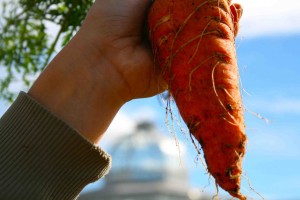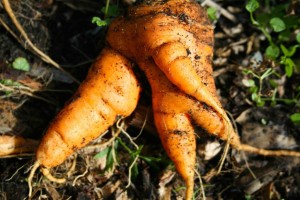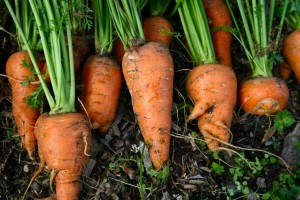The Root of the Problem
by Laura Schumm, Community Kitchen Garden Research Intern, Lewis Ginter Botanical Garden; photos by Brian Vick, Community Kitchen Garden Coordinator
Here in the Lewis Ginter Community Kitchen Garden we increased the diversity among our crops this season, and we experimented with many different root crops. We grew beets, turnips, carrots, parsnips, white potatoes and sweet potatoes. We waited until after the first few frosts to begin harvesting the carrots and parsnips; the cold weather increases the sweetness and improves the overall flavor of these veggies. Many of the carrots and parsnips looked almost perfect, but many were forked and deformed with secondary roots growing in all directions.
We were determined to get to the bottom of this mystery. I began my research by visiting many different extension agency websites, college horticulture department websites, and other gardening blogs. And I found several potential causes for our misshapen root crops. The forking we saw could have been caused by root knot nematodes, or microscopic worms that feed on plant cells and cause major damage, but these tiny insects produce noticeable galls or “knots” on the roots.
Neither our carrots nor our parsnips displayed the telltale galls associated with the nematodes so we rule them out. The mutations could also have been caused by improper bed preparation. Root vegetables like to grow in loose sandy soil with very good drainage; the soil should be free of stones and large clumps of mulch or compost. If the roots come in contact with anything hard they could be damaged or misshapen. And lastly, fertilizing, believe it or not, can also cause deformities in root veggies like carrots.
These root crops do not need as much nitrogen as some plants, and too much can cause the deformities that we’ve seen. When adding organic matter to root crop beds, it is important to ensure the compost or manure is completely cured. We planted our crops in newly built raised beds and mixed in new compost (plant material, no fresh manure), possibly a little too much though and perhaps too new.
The deformation of the carrots and parsnips we grew would likely have a major effect on their market value if we were raising them to sell, but since we grow produce to donate to FeedMore Inc. this will not be a problem for us. All in all our mutant carrots and parsnips will be just as tasty and nutritious as their better looking counterparts.
On another note, we delivered 72 lbs. of broccol and cauliflower to Feedmore Inc. this week. Year to date produce total 12,118 lbs.


